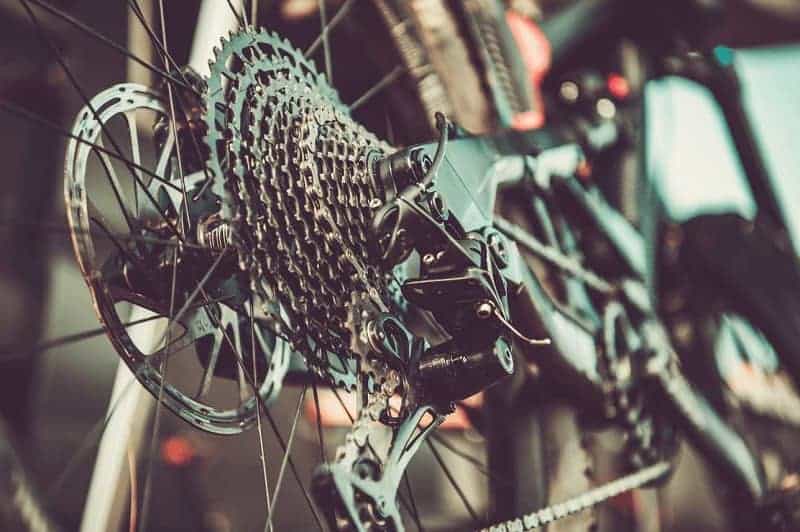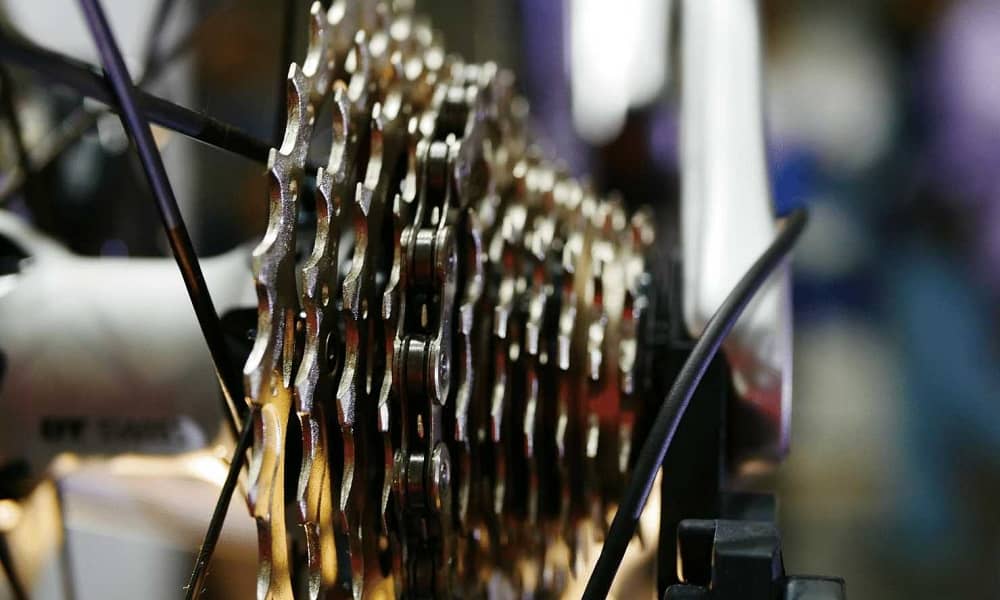Freewheel or Cassette both are very familiar words to cyclists. Ever wonder what your bike has? Freewheel or Cassette? Not just you, almost all cyclists even professionals have wondered about it sometimes. Our inner mechanic always wanted to know it of the bike we owned.
Basics
The gears of a bike’s rear-wheel referred to as a cluster usually. It can be either one from two fully different types of systems
- Freewheel
- Cassette
These rear gear (cogs) require two different types of hub system to attach to
- Freewheel
- Cassette hub or known as the freehub
Though both of these have the same function and look almost identical, there is a significant difference in mechanics. Also, keep in mind that they are not interchangeable with one another.
Freewheel
Freewheel tends to be found in an older model of bikes. Freewheels usually have a large external thread machine into the hub. The ratcheting assembled body and gear (cogs) are called “freewheel” together which threads onto the hub.
The rear freewheel hub has a standard set of threads that can screw into the freewheel and sprocket clusters. In simpler meaning, any freewheel from any brand can be mounted on any freewheel hub of any brand.
When the freewheel unthreads for removal the ratcheting mechanism comes off with the gear (cogs).
Pros of Freewheel
- Suitable for a steady ride
- It doesn’t show problems in the long run
- Allows a reverse threaded locking if the track hub is accurate
- Better for speedy acceleration
- Vintage Bikes have a Freewheel system
Cons of Freewheel
- Pedaling tightens the freewheel to the hub
- Not enough room for a lock ring
- Inefficient lock ring
Cassette
Newer models of bikes tend to have a hub type named “Cassette Hub”. These cassette hubs have a “Freehub” system which allows the clutch to be mounted to the body of the hub. The cylindrical mechanism of this system ratchets counter-clockwise for coasting and lock clockwise for driving while pedaling. The body of the freehub has a series of splines on the outer shell. The sprocket named “Cassette” slides over these splines which is what lock and hold them in place. A lockring threads into the freehub and holds the gears (cogs) in place. When the cogs are removed, the ratcheting freehub remains on the hub body. Most of the newest modern bike models have this type of freehub system.
Pros of Cassette
- The cassette breaks less than freewheel at the axle
- It can maintain high speed from pedaling
- It usually eliminates the bent axel problem which cyclists usually face
Cons of Cassette
- Price is much higher than freewheel
- More speed than you need
The difference between FREEWHEEL and CASSETTE
The main difference is that freewheel is a single-unit and pedaling tightens the freewheel to the hub. Whereas the cassette hub is a set of gears (cogs) that smoothly slides onto a cassette and held in place by a lock ring.
| Freewheel | Cassette | |
| 1. | Freewheel usually has 5, 6, or 7 speeds. | Cassette usually has 8, 9, 10, and 11 speeds. |
| 2. | The freewheel is a bit older version. | The newest models of bikes use cassettes these days. |
| 3. | The Freewheel cannot be mounted on a split freehub body. | The cassettes can be mounted on a division freehub body. |
| 4. | Freewheel has a group of gears that have a ratcheting mechanism built-into the cogs. | Cassette has a group of gears that have a ratcheting mechanism built-into the hub. |
| 5. | A freewheel threads onto the rear hub. | A cassette is not threaded onto the rear hub. |
| 6. | For the price being lower, newer bikes using 6, 7 or even 8 speed have freewheels. | Higher priced and usually found on the newest model of 9, 10, and 11-speed bikes. |
| 7. | Extractor splines do not rotate when you spin the sprocket backward. | The tool extractor splines also rotate with the cogs in the cassette. |

Now, which one do I have on my bike?
Though both freewheel and cassette look alike, it is not that hard to differentiate one from another. Mainly wheels of the bikes aren’t that common nowadays. Still many budget bikes, kid’s bikes feature freewheels. The reason behind it is to reduce the overall manufacturing costs. The chances if you have got a new bike, it’s most probably has a cassette. But there are more ways to be sure.
- If it is typically recessed slightly into the axle means it’s Freewheel.
- If it is typically flush with the face of gears, and the splines around the perimeter are seen then it is a Cassette.
- Keep in mind that Freewheel axles also show splines but not as many as Cassette does and also recessed into the body deeper over the axle.
- Freehubs usually don’t have a bulge, if it is seen, it means it’s a Cassette Freehub.
The simplest way to know if it is either a freewheel or cassette is to look at the rotating action of the innermost tool fitting of the rear wheel
- Taking off the rear wheel from the bike
- Spin the gears backward
- Freewheel = Tool Fitting doesn’t rotate along with gears
- Cassette = Tool Fitting spins with the gears alone
Remember to look for the innermost Tool Fitting as some rings will have several tool fittings.
Which one should I take? Which one is best?
These are very common questions. While discussing Freewheel and Cassette, these questions obviously tend to pop out among cyclists.
It depends on the wheelset you own. If you have a freewheel hub then changing it might need to change the hub which will cost you more. Though it might cost you more, you will get a modern wheelset with more gear options which means more speed. For racing, Cassette is the best option.
On the other hand, if you don’t want to spend much then changing just the freewheel is not that bad of an idea. You might have fewer number of gears means less speed but it won’t bother you much unless you ride for a professional reason. There is an ultra-rare 6-speed freewheel also. You might want to get a 7-speed freewheel if possible while upgrading.
The Rear Dropout Spacing Shorting
- 120 mm for 5 speed or the rare Ultra 6 speed but it is limited to freewheel.
- 126 mm for 6 or 7-speed freewheel or freehub with 7-speed cassettes.
- 130 mm: Freehub with 7 or 8 or 9 or 10 or 11-speed cassettes.
- 135 mm for the Same as 130 mm.
Now decide for yourself what do you need as you have many options and variety available in the market.
FAQs:
- What is the difference between Freewheel and Cassette?
The freewheel is a single-unit and pedaling tightens the freewheel to the hub. Whereas the cassette hub is a set of gears (cogs) that smoothly slides onto a cassette and held in place by a lock ring.
- Is Cassette better than Freewheel?
The Shimano Freehub replaced the conventional threaded rear hub around 1980. The interchangeability is lost that time which formerly existed. But these hubs were so good at that time which becomes the newer standard.
- Can a Freewheel converts to Cassette?
Nope, It is impossible. You can never convert a Freewheel to Cassette. A freewheel cannot be converted to accept a cassette of any type because these are two completely different things. It’s better to get a better hub that supports a Cassette.
- How do I know what kind of cassette to get for my bike?
You can get whatever you like but for being surer which your bikes support about check above.
- How do you remove a bicycle cassette?
Specific tools are required to remove the cassette from a bike wheel. There are many kinds of tools in the market for removing a bicycle cassette. Get one and you can remove the cassette from your bike quickly. Without tools, it’s a bit hard, and one needs to apply tricks to pull it out from the wheelset.
- How do you remove the rear freewheel cassette on a mountain bike?
First, remove the quick-release skewer and inspect the cassette, get the suitable type of remover. Then install the release skewer and that install skewer nut on the outside of the remover.
- How do I fit a new rear cassette?
What you need to do first is to remove the old one and clean these spaces and then easily you can fit a new rear cassette there.
- What is the top five Freewheel in 2021?
- SHIMANO Single-Speed Freewheels
- Altus Shimano Cassette Sprocket CS-HG31
- Origin8 Hornet 108 1/8″ Performance Freewheel
- SUNLITE Single Freewheel, 22T x 1/8″
- SunRace 5 Speed Bicycle Freewheel – Brown/Black
Final Words
The cassette replaced the conventional threaded read hub freewheel over the past few decades. It works so well that it replaced the traditional freewheel and has become standard for all types of bikes including Road Bikes, MTBs, and even Hybrids. The main difference between these two is the coasting location. It incorporates the ratchet mechanism into the hub body which helps to replace just the sprockets, rather than the whole system. Different from the Freewheel system, the lockring splines will turn with sprockets when spun backward.

